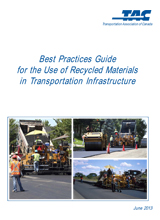Historically, the methods that have been used for evaluating the engineering and environmental suitability of new potentially recyclable materials have varied significantly across jurisdictions. As a consequence, both an ‘applicant’ (who might be an agency, constructor or supplier) who desires to use a recycled material, and a ‘decision maker’ (owners, specifiers or designers) who must determine the suitability of the application, in many cases do not have a clear or consistent approach (an evaluation framework) that can be used to proceed with such an evaluation.
The objective of this document is to provide a guide for use by agencies in identifying the various types of recycled materials and technologies which are available to them, along with their most practical/successful uses in transportation infrastructure applications.
The focus of the document is on waste and industrial by-product materials that are suitable as replacements for natural aggregates in transportation infrastructure projects. Twenty-two materials have been evaluated and grouped into six main categories: asphalt concrete, portland cement concrete, granular base and subbase materials, embankment and fill construction, stabilized bases and flowable fills.


